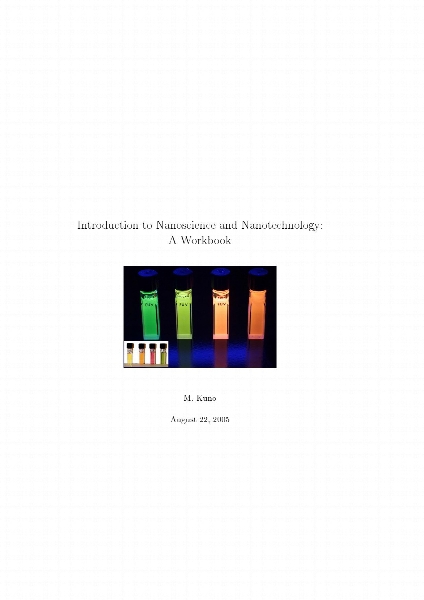Introduction to nanoscience & nanotechnology
- نوع فایل : کتاب
- زبان : انگلیسی
- مؤلف : Gabor L Hornyak; et al
- ناشر : Boca Raton : CRC Press
- چاپ و سال / کشور: 2009
- شابک / ISBN : 9781420047790
Description
Perspectives Introduction Nanoscience and Nanotechnology--The Distinction Historical Perspectives Advanced Materials Tools of Nano Nature's Take on Nano and the Advent of Molecular Biology The Nano Perspective Societal Implications of Nano Introduction to Societal Issues Ethical Implications Legal Implications Environmental Implications Public Perception Future of Nanotechnology Nanotools Characterization Methods Characterization of Nanomaterials Electron Probe Methods Scanning Probe Microscopy Methods Spectroscopic Methods Nonradiative and Nonelectron Characterization Methods Fabrication Methods Fabrication of Nanomaterials Top-Down Fabrication Bottom-Up Fabrication Computational Chemistry and Molecular Modeling Physics: Properties and Phenomena Materials, Structure, and the Nanosurface Importance of the Surface Engineering Materials Particle Shape and the Surface Surface and Volume Atomic Structure Particle Orientation Energy at the Nanoscale Surface Energy Basic Thermodynamics Liquid State Surface Energy (and Stress) of Solids Surface Energy Minimization Mechanisms The Material Continuum Material Continuum Basic Quantum Mechanics and the Solid State Zero-Dimensional Materials One-Dimensional Materials Two-Dimensional Materials Hierarchical Structures Quantum Size Effects and Scaling Laws Nanothermodynamics Thermodynamics and Nanothermodynamics Classical Equilibrium Thermodynamics Statistical Mechanics Other Kinds of Thermodynamics Nanothermodynamics Modern Nanothermodynamics Chemistry: Synthesis and Modification Carbon-Based Nanomaterials Carbon Fullerenes Carbon Nanotubes Diamondoid Nanomaterials Chemical Interactions at the Nanoscale Bonding Considerations at the Nanoscale Electrostatic Interactions Hydrogen Bonding Van der Waals Attractions Hydrophobic Effect Supramolecular Chemistry Chemistry of Nanomaterials Supramolecular Chemistry Design and Synthesis of Selected Supramolecular Species Extended Supramolecular Structures Chemical Synthesis and Modification of Nanomaterials Chemistry and Chemical Modification Self-Assembly Revisited Synthesis and Chemical Modification of Nanomaterials Template Synthesis Polymer Chemistry and Nanocomposites Natural and Bionanoscience Natural Nanomaterials Natural Nanomaterials Inorganic Natural Nanomaterials Nanomaterials from the Animal Kingdom Nanomaterials Derived from Cell Walls Nanomaterials in Insects Gecko Feet: Adhesive Nanostructures More Natural Fibers Summary Biomolecular Nanoscience Introduction to Biomolecular Nanoscience Material Basis of Life Cellular Membranes and Signaling Systems DNA, RNA, and Protein Synthesis Concluding Remarks SECTION II: Perspectives Introduction Perspectives of Nanotechnology The Business of Nanotechnology Education and Workforce Development Buildings for Nanotech National and International In-frastructure Nanotechnology Products Nanometrology: Standards and Nanomanufacturing The Transition, the Need Nanometrology and Uncertainty Quantum Metrology Nanometrology Tools Nanometrology and Nanomanufacturing Standards Nanomanufacturing and Molecular Assembly Electromagnetic Engineering Nanoelectronics Electronics and Nanoelectronics Microelectronics Nanoscale Electronics Nano-optics Introduction to Optics The Surface Plasmon Quantum Dots Near-Field Microscopies Nanophotonics Nanomagnetism Introduction Characteristics of Nanomagnetic Systems Magnetism in Reduced Dimensional Systems Physical Properties of Magnetic Nanostructures Recent Progress in Nanoscale Sample Preparation Nanomagnetism Applications Mechanical Nanoengineering Nanomechanics Introduction Three-Atom Chain Lattice Mechanics Stress and Strain Linear Elasticity Relations Molecular Dynamics Structure and Mechanical Properties of Carbon Nanotubes Nanomechanical Measurement Techniques and Applications Nano-Microelectromechanical Systems (NEMS/MEMS) Nanostructure and Nanocomposite Thin Films Introduction Classification of Nanostructured, Nanocomposite Tribological Coatings Background of Nanostructured Super-Hard Coatings New Directions for Nanostructured Super-Tough Coatings Processing Techniques and Principles General Considerations and Practical Aspects of Sputtering Deposition Applications of Thin Films Technological Applications of Thin Films Unbalanced Magnetron Sputtering of Ti--Al--Si--N Coatings Unbalanced Magnetron Sputtering of Ti--Si--B--C--N Coatings Pulsed Closed Field Unbalanced Magnetron Sputtering of Cr--Al--N Coatings Chemical Nanoengineering Nanocatalysis Introduction to Catalytic and Nanocatalytic Materials Fundamentals of Catalysis Synthesis Catalyst Characterization Nanocomposites and Fibers Nanocomposites and Fibers Physical and Chemical Properties of Materials Natural Nanocomposites Carbon Fibers and Nanotubes Organic Polymer Nanocomposites Metal and Ceramic Nanocomposites Clay Nanocomposite Materials Biological and Environmental Nanoengineering Nanobiotechnology Introduction to Nanobiotechnology The Biological Immune System Using Antibodies in Biosensors: Immunoassays Cantilevers as Nano-Biosensors Micro- and Nanosensors and Applications Optical Nanosensors Nanotechnology for Manipulation of Biomolecules Biomimetics The Bio Sciences and Technologies Biomimetic Design of Molecules Biomimetic Nanomaterials Biomimetic Nanoengineering Medical Nanotechnology Introduction to Medical Nanotechnology Nanoparticles and Nanoencapsulation for Medical Applications Guiding and Stimulating Tissue Function and Growth Environmental Nanotechnology The Environment (and Technology) Water and Soil Quality, Monitoring, and Mitigation Air Quality, Monitoring, and Mitigation Energy Epilog
Focuses on applications, examining engineering aspects as well as nanomaterials and industry-specific applications in such areas as energy, electronics, and biotechnology


